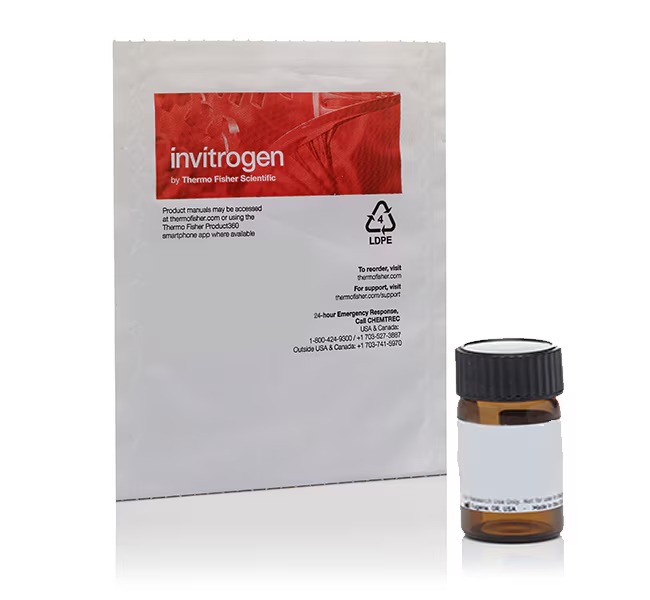Invitrogen™ MTT (3-(4,5-Dimethylthiazol-2-yl)-2,5-Diphenyltetrazolium Bromide), 1g
Catalog No :
CAS Number :
Brand :
In Stock
Specifications:
| Application | Cell Analysis | ||
| Storage Temperature | 2-8°C | ||
| Product Type | Dye | Forms | Solid |
| Product Brand | Thermo Fisher Scientific™ | ||
| Product Grade | Molecular Biology | ||
The Invitrogen™ MTT reagent is a widely used colorimetric assay for assessing cell viability, cytotoxicity, and proliferation. This reagent enables researchers to measure cellular metabolic activity as an indicator of active respiration and overall cell health.
Key Features
- Cell Viability Assessment:
- MTT is converted by metabolically active cells into an insoluble purple formazan, enabling quantification of viable cells.
- Quantitative Analysis:
- Optical density measurements correlate with cell viability and metabolic activity.
- Broad Compatibility:
- Suitable for various cell types in cytotoxicity, proliferation, and drug screening assays.
- Convenient Storage:
- Stable at room temperature and protected from light.
- Reliable and Reproducible Results:
- High-quality reagent ensures consistent performance across experiments.
Specifications
| Feature | Details |
|---|---|
| Product Type | MTT (3-(4,5-Dimethylthiazol-2-yl)-2,5-Diphenyltetrazolium Bromide) |
| Detection Method | Absorbance |
| Dye Type | Colorimetric Reagent-Based |
| Product Line | Pierce |
| Quantity | 1 g |
| Storage Conditions | Room temperature; protect from light |
| Shipping Condition | Room temperature |
| Applications | Cell viability, cytotoxicity, proliferation assays |
| Unit Size | 1 g |
Applications
- Cytotoxicity Studies:
- Evaluate the effects of drugs, toxins, and other treatments on cell viability.
- Cell Proliferation Assays:
- Quantify cell growth and division over time.
- Metabolic Activity Monitoring:
- Detect cellular metabolic health and activity.
- High-Throughput Screening:
- Test drug candidates and compounds in 96- or 384-well plate formats.
- Cancer Research:
- Assess tumor cell responses to chemotherapy agents.
Advantages
| Feature | Benefit |
|---|---|
| Sensitive Detection | Quantifies metabolic activity with high sensitivity. |
| Easy Protocols | Simple, standardized procedures. |
| Stable Reagent | Long shelf-life at room temperature. |
| Broad Application | Suitable for various cell lines and conditions. |
| High Reproducibility | Consistent performance across experiments. |
Workflow for MTT Assay
- Preparation:
- Dissolve MTT in a suitable solvent (e.g., PBS or culture medium) to prepare the working solution.
- Incubation:
- Add the MTT solution to cell cultures and incubate for 2–4 hours at 37°C to allow for formazan formation.
- Solubilization:
- Add a solubilization solution (e.g., DMSO or isopropanol) to dissolve the formazan crystals.
- Measurement:
- Measure absorbance at 570 nm (or a wavelength near the absorbance peak) using a spectrophotometer or microplate reader.
- Data Analysis:
- Compare absorbance values to a standard curve or control group to determine cell viability.
Comparison with Competitor Products
| Feature | Invitrogen™ MTT | Sigma-Aldrich MTT | Abcam MTT Cell Viability Assay Kit | Thermo Fisher CellTiter-Blue® Assay |
|---|---|---|---|---|
| Reagent Form | Powder | Powder | Kit format | Ready-to-use reagent |
| Detection Method | Absorbance | Absorbance | Absorbance | Fluorescence |
| Storage | Room temperature | Room temperature | 2–8°C | Room temperature |
| Quantity | 1 g | 1 g | Kit (100 assays) | Kit (100–1000 assays) |
| Applications | Cell viability, cytotoxicity, proliferation | Same | Same | Cell viability, cytotoxicity |
| Ease of Use | High | Moderate | Very high (kit includes all reagents) | Very high |
| Cost Efficiency | High | High | Moderate (kit format increases cost) | Moderate (higher cost per test) |
The Invitrogen™ MTT reagent is a robust, reliable, and cost-effective choice for researchers conducting cell viability, cytotoxicity, and proliferation studies. Its ease of use and compatibility with various experimental setups make it a preferred option in laboratories worldwide.
The Invitrogen™ MTT reagent has been extensively utilized in various research studies to assess cell viability, cytotoxicity, and proliferation. Below are several notable publications that have employed this product:
- "Cytotoxicity evaluation of a Thai herb using tetrazolium (MTT) and sulforhodamine B (SRB) assays"
This study compared the cytotoxic effects of a Thai herb using both MTT and SRB assays, highlighting the utility of MTT in evaluating cell viability. Jast Journal - "The MTT Assay: Utility, Limitations, Pitfalls, and Interpretation in Toxicity Testing"
This research investigated the applicability and limitations of the MTT assay in representing treatment toxicity, cell viability, and metabolic activity. MDPI - "In Vitro Cytotoxicity Analysis: MTT/XTT, Trypan Blue Exclusion"
This chapter discusses various in vitro cytotoxicity assays, including the MTT assay, and their applications in toxicology and pharmacology. Springer Link - "MTT versus other cell viability assays to evaluate the biocompatibility of implant materials"
This study compared the efficacy of the MTT assay with other cell viability assays in assessing the biocompatibility of implant materials. Wiley Online Library - "The MTT Assay: A Method for Error Minimization and Interpretation in Measuring Cytotoxicity and Estimating Cell Viability"
This protocol provides a detailed methodology for optimizing the MTT assay to minimize errors and accurately interpret results in cytotoxicity testing. Springer Link - "In Vitro Cell-Based MTT and Crystal Violet Assays for Drug Toxicity Screening"
This protocol outlines the use of MTT and Crystal Violet assays in high-throughput screening for drug toxicity. Springer Link - "Cell sensitivity assays: The MTT assay"
This article describes the MTT assay protocol, including important considerations relevant for each step of the assay, as well as its limitations and possible applications. Research Information
These publications demonstrate the widespread application of the Invitrogen™ MTT reagent in various fields of biological and medical research.




 0
0
